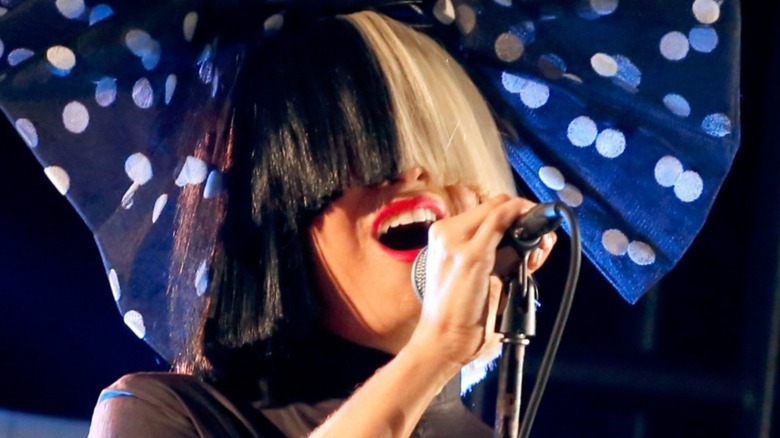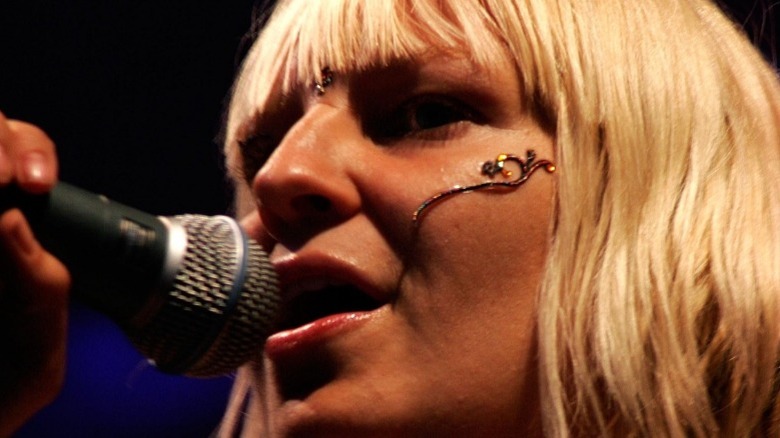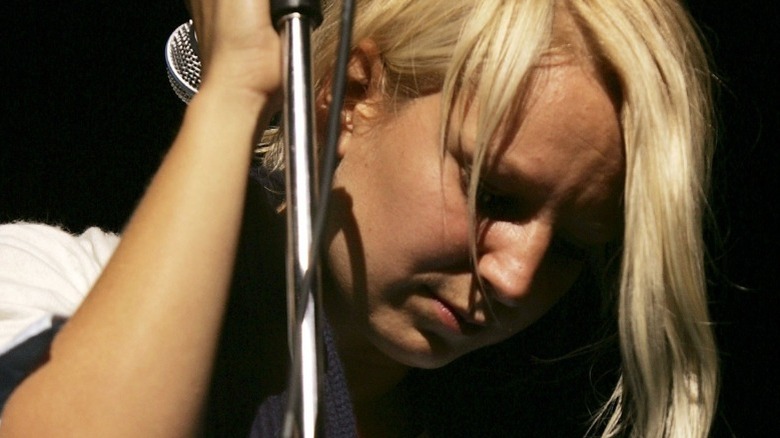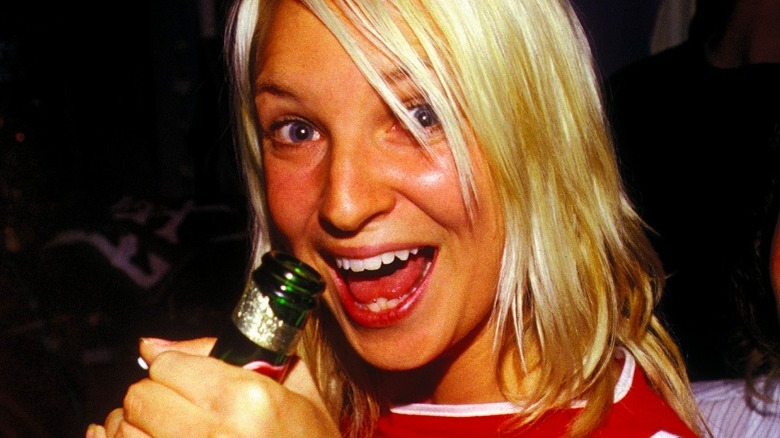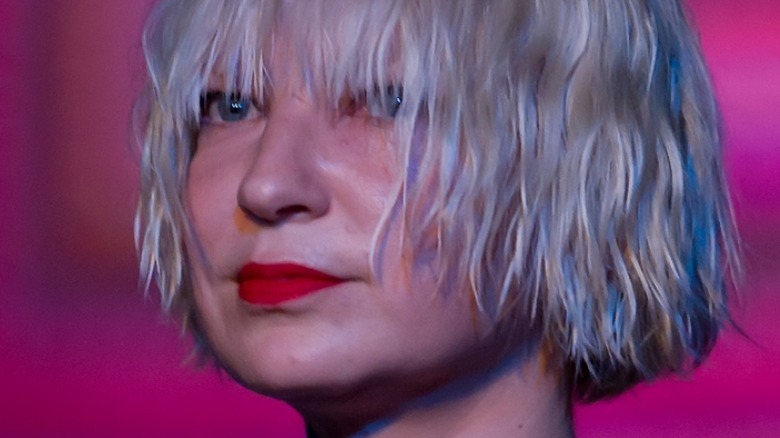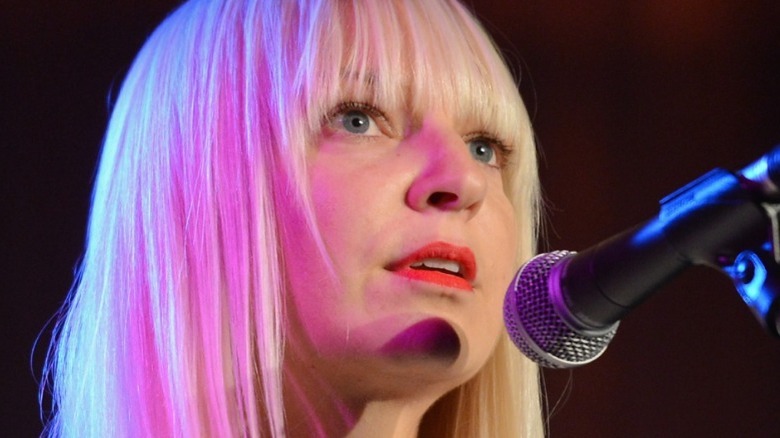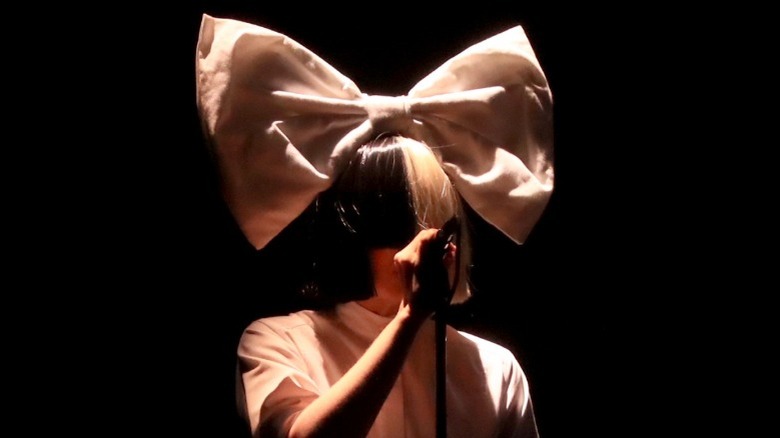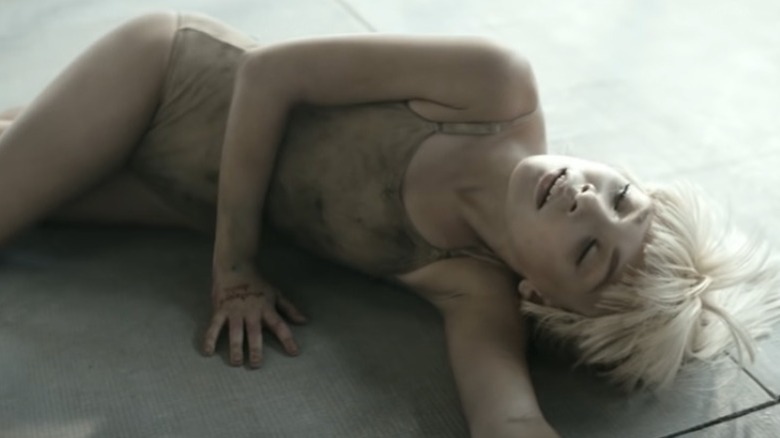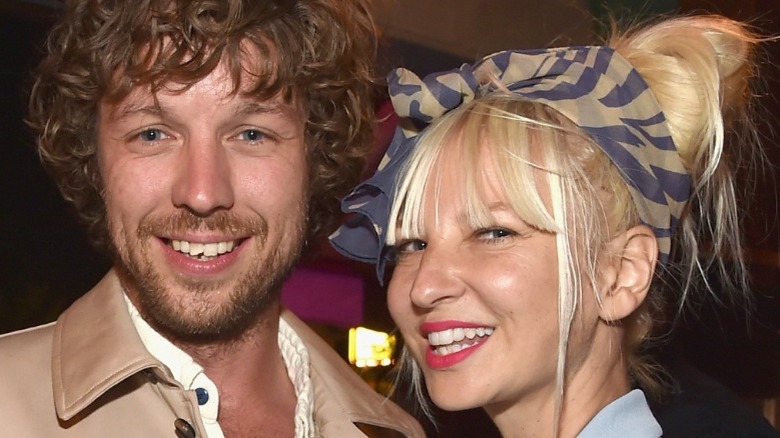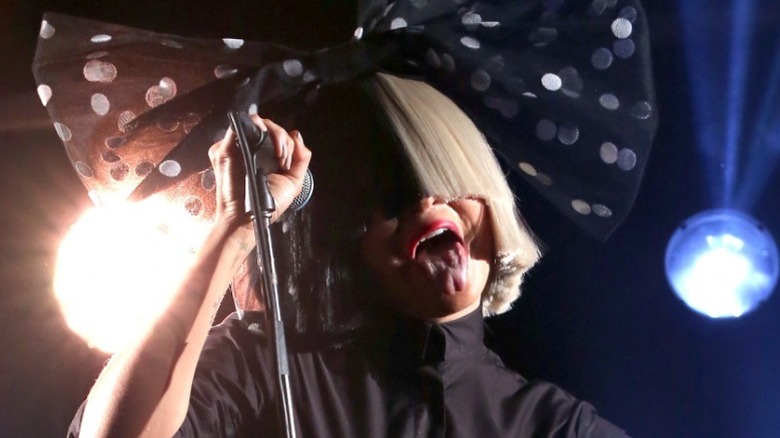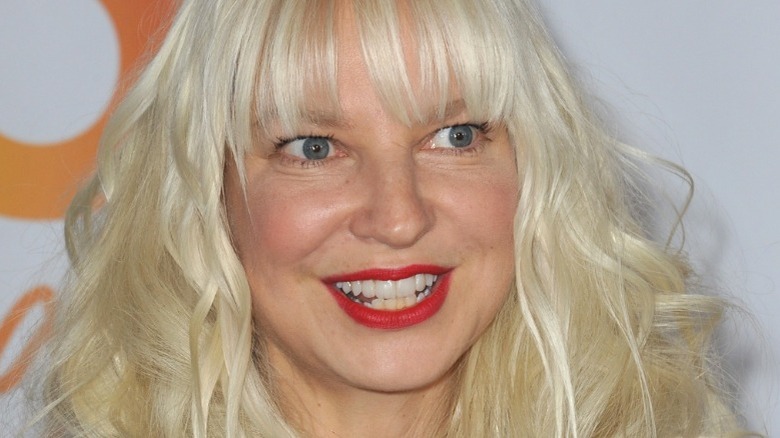Tragic Details About Sia
She was born Sia Kate Isobelle Furler, per Biography, but is now known to the world simply as Sia. The Australian songstress famous for trying not to be famous has written some 73 songs for other artists, including Rihanna's "Diamonds," Britney Spears' "Perfume," and Beyoncé's "Pretty Hurts," as per Time Magazine. She also has a storied career of her own with several solo albums under her belt. In fact, she is so prolific that, according to NPR, her aptly named Platinum-certified sixth album, "This Is Acting," is composed of tracks rejected from A-list artists like Adele.
Today, Sia is best known for her oversized face-hiding wigs and epic pop songs that tell uplifting stories of overcoming hardship such as "Chandelier," "Cheap Thrills," and "Unstoppable." But dive into her back catalog and you will also find sad indie ballads like "Breathe Me" and "I Go to Sleep."
Just like her music video for "Elastic Heart" portrays, there are two very different Sias, and they are often at war with one another. Although she is only 46 years old, Sia has already lived quite a life. From loss to illness to Twitter wars, here are some tragic details about Sia.
She has a troubled relationship with her father
Sia grew up in Adelaide, Australia, as a child of artists (per Biography). According to The New York Times, her father, Phil B. "Philby" Colson, is a blues guitarist and her mother, Loene Furler, is an art teacher. As a result, she was always surrounded by artists and musicians, including Colin Hay of Men At Work, who she refers to as "Uncle Collie." But she had a troubled relationship with her father.
In an interview with Howard Stern, she revealed that her dad had two personalities. "One was called Phil and one was called Stan," she told Stern. "Phil was like the best dad ever. He was fun but he was eloquent and he ... was present and interesting and interested. When Stan came around stuff got scary." Sia told Louis Theroux that her father would later apologize for Stan's behavior, which she described to Stern as "anguished" and "intimidating." He left when she was 10 years old.
According to Hay (via Howard Stern), Sia's father is also jealous of her career. She told Stern that he once declined her offer to sing backup on his album. But Sia forgives him. She told The New York Times, "In my sobriety, I have discovered that the people I love, and who hurt me, were sick like me."
Sia lost her first love in a tragic accident
Sia told Rolling Stone that entertaining was the way to earn love and respect in her family. So, it wasn't surprising when, at 17, she joined the local Adelaide acid jazz band, Crisp, in 1993. She sang in the band until the group broke up in 1997, as per The Sydney Morning Herald. The split worked well for Sia as she had plans to reunite with her ex-boyfriend, waiter Dan Pontifex, in London.
While in Thailand, one day before she was scheduled to visit him, her mother called her with the terrible news that Pontifex had been struck by a taxi and killed in a hit-and-run on his 24th birthday, as per The New York Times. "We'd split up but we were going to get back together and travel," she told GigWise. Instead of flying to London for a joyous reunion, she was attending his funeral.
Pontifex's death was an early source of trauma for the then 21-year-old Sia, who described him to The Adelaide Magazine as "the first love of [her] life." "I was pretty f**ked up after Dan died," she told The Sunday Times (via The Age). "I couldn't really feel anything." Her second solo album, 2001's "Healing Is Difficult," explores themes of loss in the wake of his death (per The Age).
Grief drove her to substance abuse and alcohol addiction
After attending Dan Pontifex's funeral, his friends invited Sia to move in with them. According to Rolling Stone, she ended up living in a three-bedroom house in London with 12 other grieving Australians. While in the United Kingdom, she worked as a bartender, sang back-up for Jamiroquai, fronted the electronica group Zero 7, and released several solo albums, as per Biography. But she also developed some harmful habits, regularly abusing drugs and alcohol. "Unfortunately, that bender lasted six years for me," she told The Sunday Times.
As the years went by, Sia slipped deeper into alcoholism. In an interview with Louis Theroux, she revealed that she later became addicted to Xanax, Valium, Vicodin, and OxyContin, as well. But, being a musician in her 20s, it wasn't easy to distinguish addiction from partying. "Everybody's drinking on the road," she told The New York Times, adding, "None of my friends thought I was an alcoholic, and neither did I."
Sia sought help in 2010, joining Alcoholics Anonymous and completing the 12-step program (per Louis Theroux). In 2018, she tweeted (via ET) an inspirational message to her fans, "Eight years sober today. I love you, keep going. You can do it."
If you or anyone you know is struggling with addiction issues, help is available. Visit the Substance Abuse and Mental Health Services Administration website or contact SAMHSA's National Helpline at 1-800-662-HELP (4357).
Sia has considered suicide several times – and attempted it once
Sia's haunting song, "Breathe Me," was featured in the final episode of the HBO series "Six Feet Under" in 2005, as per Vulture, bringing her moderate success in the United States. "'Breathe Me' is about feeling worried, generally anxious. Being overwhelmed by your own inner dialogue and having some sort of conniption fit and then potentially doing yourself some harm, and then asking for help," Sia explains in the video, "The Making of 'Colour The Small One.'" And, as it turned out, life imitated art. In a 2018 interview with Rolling Stone, Sia admitted that she had tried to kill herself the night she wrote it.
She considered suicide a second time in 2010, planning to check into a hotel near her apartment and end her life. She even went so far as to write a letter to her dog walker to ensure her dogs were looked after (per Louis Theroux) and prepared notes for the hotel staff (per The New York Times). But, right before leaving for the hotel to enact her plan, an old friend called. "There must have been a part of me that really wanted to live," she told Rolling Stone. "Because in that moment I thought, 'There's a world out there and I'm not a part of it. But I might like to be.'"
If you or anyone you know is having suicidal thoughts, please call the National Suicide Prevention Lifeline at 1-800-273-TALK (8255).
She was dropped from her label for making a happy album
Sia's first album, 1997's "OnlySee," only sold around 1,200 copies, as per Rolling Stone. Her second release, 2001's "Healing Is Difficult," also performed poorly and, as a result, her label dropped her. According to her interview with The Associated Press (via SF Gate), she signed with Universal for 2004's "Colour The Small One," which included the successful piano ballad "Breathe Me." But then she ran into another problem: The label wanted more sad songs.
Sia, however, had written a bunch of upbeat pop tunes for her next album. According to her interview with Richard Kingsmill, her label told her it was a terrible career move, but she insisted on recording the uptempo songs anyway. Universal responded by promptly dropping her. Shopping around for a new label, Sia made the grim discovery that the rest of the music industry agreed. The experience was upsetting. "I was in a better mood. I wanted to make a record that was like, 'Look! Things can be better!'" she told Kingsmill. "To have people identify, for the most part, with your ... fragile self-state can get you down."
In the end, she was forced to record another downtrodden album — 2008's "Some People Have Real Problems" — to appease the music industry before finally getting to release the celebratory "We Are Born" in 2010, years after it was written. The album performed well, producing the hit singles "Clap Your Hands" and "You've Changed."
She lives with chronic pain
In 2010, Sia announced on Twitter that she had been diagnosed with Graves' disease, which, according to the Mayo Clinic, is an autoimmune condition in which the thyroid gland overproduces hormones, resulting in anxiety, shaking, and fatigue. Sia told Louis Theroux that her symptoms had mimicked mental illness, causing her to be misdiagnosed with a panic disorder and given improper medical treatment for years. "I realized that I'm not crazy –- I'm sick, with a real disease," she told Nova FM (via Inertia).
And her health struggles were not over. In 2019, she took to Twitter (via Forbes) again, announcing that she had Ehlers-Danlos Syndrome, a genetic condition that impacts connective tissues and causes joint pain, as per the Mayo Clinic. According to Rolling Stone, Sia also suffers from frequent migraines as well as back and neck pain. "I just wanted to say to those of you suffering from pain, whether physical or emotional, I love you keep going," she Tweeted (via Forbes) following her 2019 diagnosis. "Life is ... hard. Pain is demoralizing, and you're not alone."
Sia doesn't want to be famous
After five solo albums, a decade of touring, and a long struggle with addiction, Sia realized that fame — even the moderate amount she had achieved — was negatively impacting her mental health, as per Louis Theroux. "When the paparazzi start to follow you it's like being prey. It's like their cameras are guns and you're a deer," she told Louis Theroux, adding, "I thought [fame] was going to rescue me and it didn't." Sia also admitted to Theroux that she suffered from severe performance anxiety and had to either drink, or, after she became sober take a beta-blocker, to get on stage.
Following her fifth album in 2010, she decided to stop performing and releasing music, focusing instead on writing pop songs for other artists, as per NPR. Although hesitant at first, she returned to her craft after hearing from her fans (per Louis Theroux). She released the electropop song "Chandelier" in 2014, and it became a smash hit. Her sixth solo album, "1000 Forms of Fear," came out later that year.
But, according to The Guardian, when it was time to tour, she donned an oversize wig that concealed most of her face and sang from the back of the stage — sometimes, per News.com.au, facing away from the audience — allowing dancers like child star Maddie Ziegler (who donned a matching wig) to act out her songs. In a further attempt to thwart her growing fame, Sia stopped allowing herself to be photographed (per NPR). She also posed on the cover of Billboard Magazine with a paper bag over her head and wrote an "Anti-Fame Manifesto," in which she declared, "Me and fame will never be married."
She was diagnosed with complex post-traumatic stress disorder
In a candid moment during her interview with Louis Theroux in 2020, Sia revealed that she had originally been diagnosed with bipolar disorder but her therapist determined that she actually suffered from complex post-traumatic stress disorder. When Theroux, a friend of hers, asked why, Sia provided an elaborate overview of her life's traumas.
First, she cited her childhood, in which her father had an intimidating alter-ego and her mother had postpartum depression. She also revealed that she had been abused at age 9. Next, she explained how one of her neighbors who had desperately tried to befriend her later died by suicide, breaking into tears while recounting the tragedy. The sudden death of her boyfriend Dan Pontifex also had a lasting impact on her.
Sia also witnessed a brutal gang attack. Being the first on the scene, she called the authorities and applied first aid to the victim until the ambulance arrived. Later, she was summoned to court as a witness. After they read out her home address, she claims one of the perpetrators looked right at her and said, "You're next." She also cites fame as a traumatic event in her life.
If you or anyone you know has been a victim of sexual assault, help is available. Visit the Rape, Abuse & Incest National Network website or contact RAINN's National Helpline at 1-800-656-HOPE (4673).
She was accused of sexualizing a child in the video for Elastic Heart
In 2015, Sia released a music video for her song "Elastic Heart." The video featured then 12-year-old Maggie Ziegler clad in a dirty beige leotard performing an interpretive dance with then 28-year-old Shia LeBeouf. While both are clothed — albeit scantily — and there is nothing overtly romantic occurring, the video drew immediate criticism.
According to Time Magazine, Sia was accused of sexualizing child dancer Ziegler, and "Elastic Heart" was even ranked as one of the 10 most controversial music videos, as per The Telegraph. "I anticipated some 'pedophilia'!!!' cries for this video," Sia said on Twitter (via People) shortly after its release. "All I can say is Maddie and Shia are two of the only actors I felt could play these two [warring] 'Sia' self states." In a second Tweet she added, "I apologize to those who feel triggered ... My intention was to create some emotional content, not to upset anybody."
While the video certainly had its share of haters, several journalists came to its rescue. Michelle Geslani of Consequence claimed that the video merely illustrates an interpretive dance, and Barbara Ellen of The Guardian argued that Ziegler was dressed similarly in the music video for "Chandelier," which garnered no controversy.
She has been exceptionally unlucky in love
Sia developed a crush on fellow musician JD Samson of Le Tigre. In an interview with Independent.ie, she claims she first saw Samson on MySpace and booked her to DJ a party just for the chance to meet her. The pair dated until 2011 when they amicably called it quits. But, following the relationship, Sia told Louis Theroux that she joined Sex and Love Addicts Anonymous.
Sia announced her engagement to filmmaker Erik Anders Lang (pictured) in 2014 after just two weeks of dating, as per Rolling Stone. Two years later, they were divorced. "I felt very duped and very, very devastated," she told Theroux.
In 2020, Sia revealed that she had been romantically involved with Shia LeBeouf when she took to Twitter to support fellow artist FKA Twigs, who had alleged that LeBeouf was abusive and filed a lawsuit against him, as per E-News. "I too have been emotionally hurt by Shia, a pathological liar, who conned me into an adulterous relationship claiming to be single," she Tweeted. "I believe he's very sick and have compassion for him AND his victims." Sia later elaborated on their relationship in an interview with The Sunday Times, claiming that he was dating her and FKA Twigs at the same time — telling both he was single — when he was actually still married to actress Mia Goth.
If you or someone you know is dealing with domestic abuse, you can call the National Domestic Violence Hotline at 1−800−799−7233. You can also find more information, resources, and support at their website.
The paparazzi tried to sell a nude photo of her online
Despite all of Sia's efforts to stay out of the limelight, the paparazzi managed to snap a nude photo of her in November of 2017. According to The Guardian, the photo ended up for sale online along with 15 other pictures of her.
Sia, who told Howard Stern she only allows the press to take photos of her at animal or LGBTQ rights benefits, responded by sharing the nude photo on her own social media pages. Taking the power back, Sia used the violation of privacy to plug her album, "Everyday is Christmas," which came out a month later, captioning the post: "Someone is apparently trying to sell naked photos of me to my fans. Save your money, here it is for free. Every day is Christmas!" (via The Guardian).
Still, the invasive photo leak was a cruel twist of fate for Sia, who has long struggled with anxiety related to fame and its vultures.
Insecurity drove her to plastic surgery
In a 2021 interview with Dr. Gabor Maté, Sia admitted that she had gotten plastic surgery to remove her double chin twice, thinking it was fat. But, as it turned out, it was actually muscle tissue that she needed for singing. Later in the interview, she revealed that liposuction had left her stomach permanently altered, telling him that it "looks like someone threw a hammer into [her] guts" and describing the procedure as awful. She also confessed to having received Botox treatments on her face. Sia claims that insecurity drove her to alter her body. "I had this idea that I had to be beautiful in order to be a pop star," she told Maté.
According to Rolling Stone, Sia, like many people in show business, is constantly dieting. This is yet another facet of fame she wishes she could do without. "I would like not to be picked apart or for people to observe when I put on ten pounds or take off ten pounds or I have a hair extension out of place or my fake tan is botched," she told Kristen Wiig in an interview for Interview Magazine. "Most people don't have to be under that pressure, and I'd like to be one of them."
She received intense backlash for her film, Music
In 2021, Sia was thrilled to finally release her passion project, "Music," a film about an autistic youth and her drug dealer sister, which she co-wrote and directed. Her joy was short-lived, as the film caused an outcry among disability activists. The trouble started when, per Billboard, she cast neurotypical teen dancer, Maggie Ziegler — the star of several of her music videos and her avatar during live performances — as the film's lead rather than an autistic actor.
Amid accusations of being ableist and not consulting the disabled community regarding the film, Sia claimed on Twitter that she had attempted to cast a non-verbal autistic girl for the role but she had found the experience too stressful (via NME). A fierce social media battle ensued, in which Sia personally responded (sometimes harshly) to around 40 people on Twitter, as per Vulture. Sia also defensively tweeted (via Variety), "The movie is both a love letter to caregivers and to the autism community," and "My heart has always been in the right place."
According to The Mighty, the autism community took issue with a scene in which the autistic character, Music, is forcibly restrained during a meltdown. A petition to rescind the movie's Golden Globe nominations followed. Sia took to Twitter again to issue an apology, vowing to remove all restraint scenes. "I listened to the wrong people, and that is my responsibility," she tweeted (via NME). "My research was clearly not thorough enough, not wide enough." She left the tweets up for one hour, then, per Yahoo!, she deactivated her Twitter account. Following the year of backlash, Sia experienced a relapse and went to rehab, as per The New York Times. She credits her friend, comedian Kathy Griffin, with saving her life.
